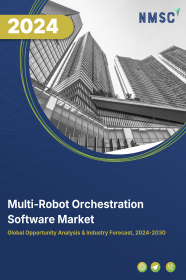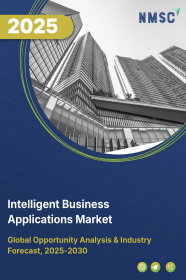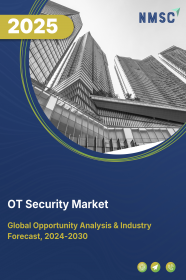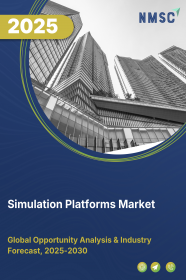
Multi-Robot Orchestration Software Market by Component (Software and Services), by Control Level (Low-level Control and High-Level Control), by Deployment Mode (Cloud-based and On-premise), by Robot Type (Industrial Robot, Service Robot, Collaborative Robots, and Mobile Robots), and by Application (Manufacturing and Logistics, Healthcare, Agriculture, Retail and Hospitality, Construction and Mining, Defense and Security, and Others) – Global Opportunity Analysis and Industry Forecast 2024-2030
US Tariff Impact on Multi-Robot Orchestration Software Market
Trump Tariffs Are Reshaping Global Business
Multi-Robot Orchestration Software Market Overview
The global Multi-Robot Orchestration Software Market size was valued at USD 0.18 billion in 2023 and is predicted to reach USD 1.84 billion by 2030 with a CAGR of 33.8% from 2024-2030. Multi-robot orchestration software, also known as fleet orchestration software that refers to a specialized system that manages and optimizes the coordination, deployment, and performance of a fleet of robots within an industrial setting.
This software plays a crucial role in orchestrating the various activities of these robots to achieve efficient and synchronized operations across the industrial facility. The key functionalities include task allocation, route optimization, real-time monitoring, and data analytics, contributing to increased productivity, resource optimization, and seamless collaboration among the robotic fleet. The primary goal this market is to enhance the overall operational efficiency, reliability, and adaptability of industrial processes where multiple autonomous vehicles are employed for tasks such as material handling, logistics, or automation.
Market Dynamics and Trends
The increasing adoption of autonomous mobile robots (AMRs) in logistics and operations management is fueling the demand for multi-robot orchestration software, which coordinates multiple robots to enhance efficiency and productivity in warehouses. This software plays a vital role in optimizing robotic fleet operations, enabling seamless coordination and improved performance in industrial settings. Recently, CoEvolution Technology launched its fleet orchestration software focusing on logistics and warehouse operations improvement. The software solutions include synergized robot control systems, automation process orchestration, and smart logistics simulators, allowing them to operate as a homogeneous fleet.
Also, the growing e-commerce industry boost the demand for efficient robot-fleet management software among the warehouses and fulfilment centres. This helps in optimizing delivery routes, managing vehicle utilization, and improving overall logistics for e-commerce businesses. According to the International Trade Administration (ITA), the global B2C e-commerce revenue is expected to grow at USD 5.5 trillion by 2027 as compared with 2023 with a revenue of USD 3.6 trillion. However, the high upfront costs associated with implementing multi-fleet orchestration software, including hardware, software licenses, and training is hindering the market expansion.
On the contrary, the integration of advanced technology, such as the Internet of Things (IoT), artificial intelligence (AI) contributes to the development of more sophisticated robot-fleet orchestration solutions. These technologies enable real-time monitoring, predictive maintenance, and data-driven decision-making. Recently, AWS launched its IoT RoboRunner service which is designed to bring interoperability in robot fleets and enable greater ease of use and management. It is based on the same technology Amazon uses to manage and monitor its network of warehouse robots and automation solutions.
Market Segmentation and Scope of Study
The multi-robot orchestration software market report is divided on the basis of type of component, control level, deployment mode, robot type, application and region. On the basis of type of component, the market is divided into software and services. The software segment is again divided into robot operating system (ROS), fleet management software, simulation software, and communication protocols. The service segment is again sub-divided into consulting, integration services, and support & maintenance services. On the basis of control level, the market is categorized into low-level control and high-level control. On the basis of deployment mode, the market is segmented into cloud-based and on-premise. On the basis of robot type, the market is classified into industrial robot, service robot, collaborative robots, and mobile robots. On the basis of application, the market is bifurcated into manufacturing and logistics, healthcare, agriculture, retail and hospitality, construction and mining, defense and security, and others. Regional breakdown and analysis of each of the aforesaid segments includes regions comprising of North America, Europe, Asia-Pacific, and RoW.
Geographical Analysis
Asia-Pacific holds the dominating share of multi-robot orchestration software market at present and is expected to continue its dominance throughout the forecast period. This is attributed to factors such as the surge in e-commerce activities across this region. As this software helps in optimizing delivery routes, reducing delivery times, and enhancing overall logistics efficiency. According to the International Trade Administration (ITA), India is one of the fastest growing economies for e-commerce market with a revenue of USD 46.2 billion in 2020 and is expected to grow at USD 136.47 billion by 2026.
Also, the advent of cutting-edge technologies, including the Internet of Things (IoT), artificial intelligence, plays a pivotal role in advancing the evolution of highly sophisticated solutions for orchestrating robot fleets. For instance, in March 2023, Weg launched its IoT based autonomous mobile robots (AMRs) called the WMR designed to optimize manufacturing operations and production logistics in the industry. The management and monitoring of these robots in warehouse operations are facilitated through robot fleet management software. This software has the capacity to integrate with various robot brands and models, simulate different scenarios, analyze conflicts, and support multiple user management.
On the other hand, North America is considered fastest growing region in the fleet orchestration software industry owing to the increasing demand for automation and efficiency in various industries such as manufacturing, logistics, and others. These industries are leveraging robot software to reduce costs, increase output, improve efficiency, and enhance safety in their operations. For instance, in March 2023, CoEvolution Technology launched its AI-powered software that controls different types of robots and coordinate them seamlessly, allowing them to operate as a homogenous fleet. This software is focused on improving logistics by enabling the integration and coordination of diverse robot fleets from multiple vendors.
Moreover, the leading companies are adopting various business strategies including partnership which in turn is boosting the multi-robot orchestration software market growth. For instance, in February 2023, Clevon AS partnered with ZF, a global technology company, to integrate ZF's SCALAR software-as-a-service platform with CLEVON 1 vehicles for real-time fleet orchestration. This collaboration aims to enhance fleet management capabilities, focusing on planning, vehicle routing, and data processing.
Competitive Landscape
Various key players in the multi-robot orchestration software industry includes CoEvolution Technology LLC, Locus Robotics, Zebra Technologies Corp., Vecna Robotics, GreyOrange, Verizon, Geekplus Technology Co., Ltd., InOrbit, Inc., Meili Robots, SynaOs, UiPath, Inc., Vecna Robotics, Omron Corporation, Excelacom Inc., FlexRule and others. These market players are opting various strategies such as collaboration to maintain their dominance in the global market.
For instance, in March 2023, Locus Robotics launched LocusONE, a warehouse orchestration platform designed to power centrally managed multi-bot AMR automation. This innovative platform utilizes data science to optimize warehouse productivity by integrating with any WMS system, providing flexible fleet management, and enabling the deployment of various AMRs tailored to specific warehouse needs.
Moreover, in November 2022, InOrbit introduced a developer edition software and extended the InOrbit Connect program to include a broader range of robots. This enables organizations deploying robots, such as robot developers, systems integrators, or end users, to create sophisticated solutions using InOrbit's comprehensive platform
Key Benefits
-
The report provides quantitative analysis and estimations of the multi-robot orchestration software market from 2024 to 2030, which assists in identifying the prevailing market opportunities.
-
The study comprises a deep-dive analysis of the current and future multi-robot orchestration market trends to depict prevalent investment pockets in the market.
-
Information related to key drivers, restraints, and opportunities and their impact on the multi-robot orchestration software market is provided in the report.
-
Competitive analysis of the key players, along with their market share is provided in the report.
-
SWOT analysis and Porters Five Forces model is elaborated in the study.
-
Value chain analysis in the multi-robot orchestration software market study provides a clear picture of roles of stakeholders.
Multi-Robot Orchestration Software Market Key Segments
By Components
-
Software
-
Robot Operating System (ROS)
-
Fleet Management Software
-
Simulation Software
-
Communication Protocols
-
-
Services
-
Consulting
-
Integration Services
-
Support & Maintenance Services
-
By Control Level
-
Low-level Control
-
High-level Control
By Deployment Type
-
Cloud-based
-
On-premise
By Robot Type
-
Industrial Robot
-
Service Robot
-
Collaborative Robots
-
Mobile Robots
By Application
-
Manufacturing and Logistics
-
Healthcare
-
Agriculture
-
Retail and Hospitality
-
Construction and Mining
-
Defense and Security
-
Other Applications
By Region
-
North America
-
The U.S.
-
Canada
-
Mexico
-
-
Europe
-
The UK
-
Germany
-
France
-
Italy
-
Spain
-
Denmark
-
Netherlands
-
Finland
-
Sweden
-
Norway
-
Russia
-
Rest of Europe
-
-
Asia-Pacific
-
China
-
Japan
-
India
-
South Korea
-
Australia
-
Indonesia
-
Singapore
-
Taiwan
-
Thailand
-
Rest of Asia-Pacific
-
-
RoW
-
Latin America
-
Middle East
-
Africa
-
Report Scope and Segmentation:
|
Parameters |
Details |
|
Market Size in 2023 |
USD 0.18 Billion |
|
Revenue Forecast in 2030 |
USD 1.84 Billion |
|
Growth Rate |
CAGR of 33.8% from 2024 to 2030 |
|
Analysis Period |
2023–2030 |
|
Base Year Considered |
2023 |
|
Forecast Period |
2024–2030 |
|
Market Size Estimation |
Billion (USD) |
|
Growth Factors |
|
|
Countries Covered |
28 |
|
Companies Profiled |
10 |
|
Market Share |
Available for 10 companies |
|
Customization Scope |
Free customization (equivalent to up to 80 working hours of analysts) after purchase. Addition or alteration to country, regional, and segment scope. |
|
Pricing and Purchase Options |
Avail customized purchase options to meet your exact research needs. |
KEY PLAYERS
-
CoEvolution Technology LLC
-
Locus Robotics
-
Zebra Technologies Corp.
-
Vecna Robotics
-
GreyOrange
-
Verizon
-
Geekplus Technology Co., Ltd.
-
InOrbit, Inc.
-
Meili Robots
-
SynaOs
-
UiPath, Inc.
-
Vecna Robotics
-
Omron Corporation
-
Excelacom Inc.
-
FlexRule

















 Speak to Our Analyst
Speak to Our Analyst




















